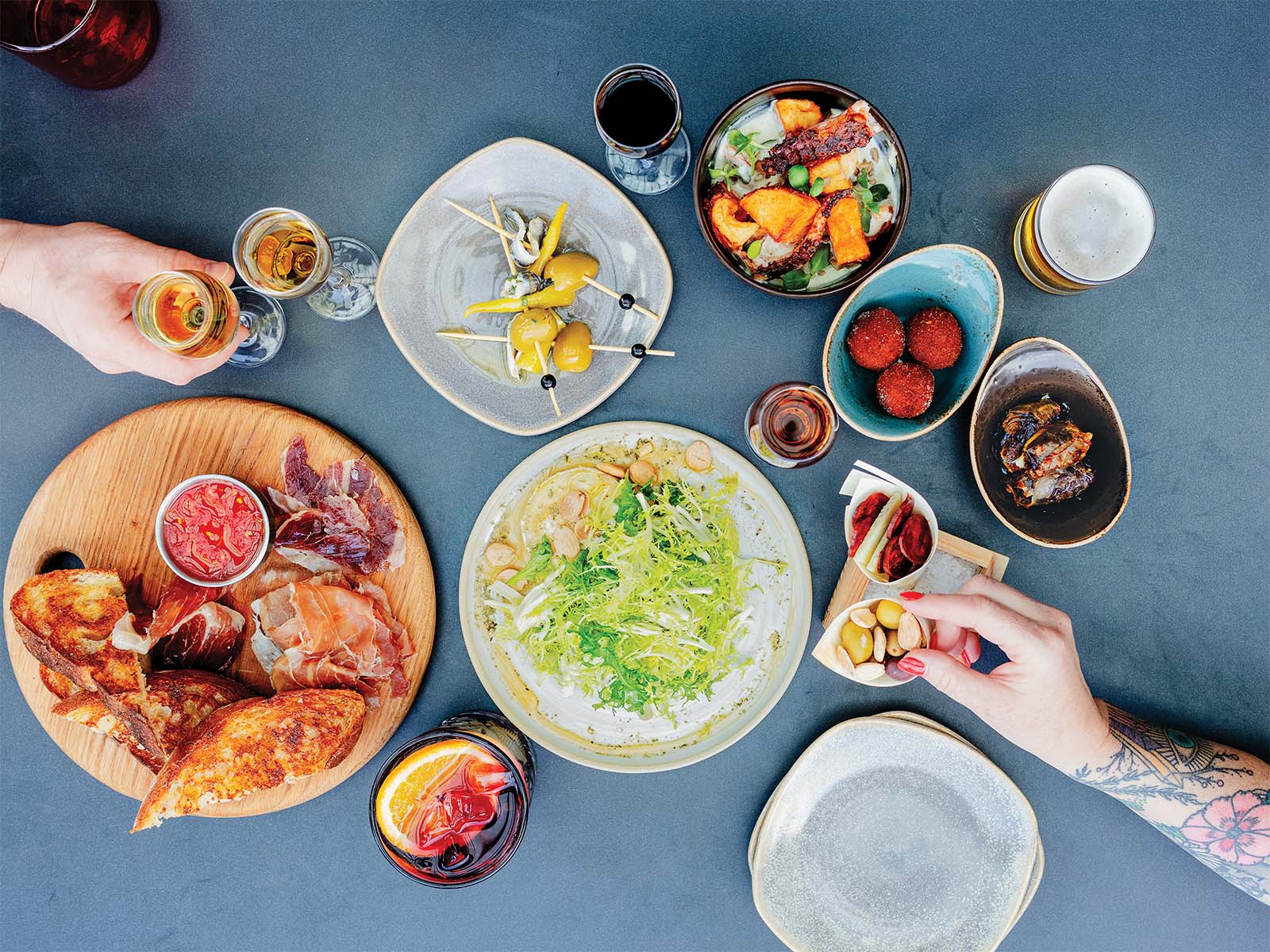The Local newsletter is your free, daily guide to life in Colorado. For locals, by locals.
Ulteria
2 Stars
- The Draw:
- A taste of Spain and Portugal inside bustling Union Station
- The Drawback:
- Entrées disappoint; gin tonics need revamping
- Don’t Miss:
- Ham and sherry selections, croquettes, tempura-fried eggplant, shrimp tortilla, frisée salad, roast pork
“Who would have thought,” my wife said, as we walked back to our pensión in the Spanish city of San Sebastián, “that one of the best dinners of your life would be a goddamned ham sandwich?”
“Hmmm,” I agreed. It was simple perfection: hand-shaved slices of aged jamón Ibérico in a crackly crusted miniature baguette. We had also eaten a locally famous cheesecake, burnt brown about its edges and oozing from the middle like a ripe Brie.
“Almost sexual,” I said.
“Oh, baby,” my wife hooted. “Way beyond sexual!”
Such is the siren song of the Spanish table. As I write, I’m halfway through an eating expedition from Barcelona to Bilbao, and because the subject of this review is Ultreia—the eight-month-old Iberian restaurant in Union Station—this feels especially germane. Ultreia calls itself a “gastroteka/gin tonics” joint and is dedicated to the very “pintxos” (snacks on bread), “tapas” (small plates), and “raciones” (entrées) I’ve been eating in Spain.
The excitement and candy-store bounty of a pintxos bar at dinnertime is infectious: Two dozen offerings may range down the bar, from fried fish fillets to battered meatballs to paper-thin slices of ham to rich crab salad, all served on slices of bread, as well as croquettes, octopus, and more. Elbow work gets you in position to request an empty plate and then, in many establishments, to help yourself to whichever treats you desire. You eat a few things, sip a small glass (or two) of cider or beer, and move on to the next bar. (You can also sit at a table, order a few raciones and a bottle of Rioja, and relax the pace of your evening.)

This is the exuberant style of eating that Ultreia surely aspires to. But Ultreia’s chefs, Jennifer Jasinski—of Rioja and James Beard Foundation Award fame—and Adam Branz, hail from Southern California and Illinois, respectively, both thousands of miles from Spain’s western coast, so it makes little sense to talk about authenticity in a strict way. What should concern us is the quality of imitation: How well does Ultreia honor the Iberian eating experience in the context of Rocky Mountain residents who tend not to scrum (or even sit) for dinner at 10 p.m. on a weeknight?
Ultreia succeeds in several respects. Its Union Station location has the urban bustle necessary for this convivial style of eating. The space manages an Old World patina, with high ceilings, moldings, pendant lamps, Dutch murals, slate blue paint, and a tile staircase leading to a small second-floor mezzanine. The long, granite-topped bar is the heart of the establishment, as it should be. There’s a leg of ham resting on the bar just inside the front door, along with cones of pintxos—all very Spanish-like.
More than half of Ultreia’s menu is devoted to “bare hands” foods and small plates: little wooden picks of Basque peppers, olives, and anchovies called “gildas”; ham on bread; patatas bravas; chorizo and cheese plates; stuffed peppers; and croquettes. To start, settle in at the bar or at one of the small tables and order the three-variety ham plate. The two-year-old serrano is tender, like young prosciutto; the three-year-old Mangalica has an emergent sweetness; shards of dark purple, four-year-old, acorn-fed jamón Ibérico de bellota add funk and tongue-drying tannic umami. The ham comes with crunchy toast—better than a lot I’ve had in Spain—brushed with olive oil. Alternatively, you can snack on ham or anchovies on tomato-smeared bread. Order, too, a few of the gildas. With a glass of cava, these lively treats make for happy eating.
There is more in this line. “Berenjenas” are crisp, sesame-coated rounds of tempura-fried eggplant, sweetened with honey and all creamy inside. Ultreia’s croquettes are excellent, gooey and filled with bits of salty ham. The ham-wrapped dates—stuffed with goat cheese—are also enjoyable, dense and sweet and offset by a sprinkle of crunchy salt. “Tortillas de camarones” come as a single, delectable toasty-brown pancake flecked with sweet shrimp. And from the “tools required” side of the menu, I recommend the “escarole rizada” (frisée) salad for its thick disk of superb Caña de Cabra cheese, which is smooth and soft, with a delicate, bloomy skin.

This is all good drinking food, especially with that cava or a glass of wine from the list of Spanish reds. But Ultreia’s gin tonics—Spaniards drop the “and”—are another matter.
It was in a Barcelona gin tonic temple called Bobby Gin that I watched the Spanish versions being made in huge goblets, filled to the top with massive ice cubes. The ice is swirled in the glass to chill it, and then the water is drained off. The tonic is poured down a long swizzle stick or over the back of a spoon to minimize loss of fizz. In serious bars, sharp flavorings are added—bitters, extractions of dried fruit, oils of citrus peel, that sort of thing. The obsession is with amplifying the gin aromatics while preventing dilution. Much of this is imitated at Ultreia, including the goblets, but with the addition of things like crème de violette, Aperol, and (thankfully no longer on the menu) spirulina simple syrup. I found the results unnecessarily complicated, watery, oversweet, and lacking intensity.
Console yourself instead with Ultreia’s sherries, which run from austere, pale finos to nutty olorosos to deep purple Pedro Ximénez–style wines. There are 14 such beauties on the Ultreia list, including a flight of three one-ounce servings for less than $13. There’s also a sour, bready Isastegi (a family-made Basque cider) that tastes exactly right sipped alongside those sweet dates.
Among the handful of entrées, there is cod, poached in olive oil and served with asparagus, peas, and fava beans, and there is “fideuà,” a noodle variant of paella that is something of a deep cut from the Spanish culinary album. The menu also includes a few Portuguese dishes, like “caldo verde” (a potato-kale soup) and mussels flavored with linguiça.
Ultreia’s kitchen is less confident with these larger plates. One evening, a romaine salad, for example, came with shrimp and fried squid that were drained of flavor, like an old Al Gore speech. The fideuà, filled with bland seafood and practically raw mussels, suffered the same flaw. The cod was flavorful, but its accompanying red-hued sauce and green rice added neither texture nor taste. I did, however, enjoy the roast pork shoulder, which was tender yet dense, almost like a confit. And when it came time for sweets, I loved a luscious olive oil sorbet and a salty, cocoa-rich ice cream made crunchy from bits of toasted Marcona almonds.
There’s work to be done with the entrées, but I’d just as soon see Ultreia double down on the hand foods and small plates and achieve something closer to the festival mood of a true Spanish pintxos bar. This would offer a different way of eating for Denverites. Is such a cultural shift possible? Union Station has the requisite hustle; imagine that clamorous vibe, plus dozens of the treats I’ve described, in splendid profusion. Who wouldn’t want to eat that way? After my Spanish wanderings, I certainly do.









